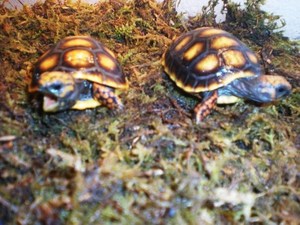Red Footed Tortoises are among the most popular tortoise species in the American pet trade, and with good reason. These gregarious, social tortoises are well known for their friendly and even comical nature, their ability to bond with humans, and their small size relative to other popular tortoise pets. These tortoises grow to be 12-18 inches across, and although this is quite large, is still smaller than some other popular tortoises. If you’re interested in adopting a Red Foot Tortoise, or already have one and need to learn more, here are the basics:
Housing
Like all other tortoises, an aquarium is not an ideal enclosure of a Red Foot Tortoise. There are a few reasons for this. First, the air circulation is generally poor. Second, when tortoises can see through their enclosure, they’re likely to spend a large portion of their day trying to escape and may become stressed or injured. And finally, Red Foot Tortoises will very quickly outgrow an aquarium, and only the largest aquariums will be big enough for even babies. Aquariums with backgrounds on three sides that prevent tortoises from seeing the glass are acceptable as short term housing for babies if, and only if, there is adequate ventilation in the aquarium.
Ultimately, you will have to build a tortoise table, which is a better enclosure for red foot tortoises. For simple instructions on how to do this, check out this site.
The ideal long term enclosure for your red footed tortoise is outside, in an enclosed and protected area. This will provide your tortoise with appropriate sunlight, roaming room, and food to eat. This site provides a helpful overview of how to establish a healthy outdoor enclosure for your tortoises.
While your tortoise is housed indoors, there are a few important considerations. First, humidity. Red Foot Tortoises are tropical tortoises and accustomed to high humidity. Consequently, you will need a bedding or substrate that holds moisture well. Many people use nontoxic soil or peat moss. However, I’ve found the biggest challenge with Red Foot Tortoise substrate is preventing bugs and mold. Mosser Lee Moss is particularly good for this and tends not to get too dusty either. Mist the moss and your tortoise several times a day to maintain adequate humidity levels in the enclosure.
Second, your Red Footed Tortoise will need a place to hide. Provide her with several small boxes or logs where she can burrow and hide.
Finally, it is important to be mindful that Red Foot Tortoises, much like babies, will put any and everything in their mouths. Consequently, it is important that there is nothing toxic in the enclosure and nothing they can choke on. Carefully remove wrapping from any cage furniture you buy and make sure the substrate you choose is nontoxic.
Heat and Lighting
Red Foot Tortoises are susceptible to a variety of health problems if the temperature in their cage is not appropriate. Ideally, your tortoise should be provided with a gradient: a hot side and a cooler area. The basking area should be 85-95 degrees, and the cooler area should be room temperature. You can accomplish this with a heat light (or several heat lights together if one is not doing the trick). Do not use a heat rock or heating pad; these can burn your tortoise. Also, make sure that the heat light is sufficiently far away from the cage or else your tortoise can burn himself on it. Most importantly, do not allow the temperature on the hot side of the cage to get too hot. Baby tortoises tend to tip over, and if a tortoise tips over and cannot flip back over, he can cook to death under the heat light.
Red Foot tortoises need UVB sunlight in order to metabolize calcium and maintain a healthy shell. To help your tortoise do this, provide her with an artificial UVB light, available at your local pet store. You can also take her outside to walk around once a day to give her the added boost of sunlight. Without this vitally important light, your tortoise will get metabolic bone disease and may ultimately die.
Food and Water
Unlike other popular tortoise breeds that thrive on diets of grass and weeds, Red Foot Tortoises not only can thrive on vegetables but also need some protein. Feed your tortoise greens like mustard, turnip, and collard greens, and provide her with protein once per week by giving her re-hydrated dry cat food. Your tortoise will also love geranium and hibiscus flowers and rose flowers, as well as zucchini squash, all of which are excellent sources of calcium.
In order to ensure that your tortoise gets enough calcium, either dust her food with calcium dust daily, or provide her with a cuttle bone to chew on. Cuttle bones are cheap and have the added benefit of allowing your tortoise to determine when he needs extra calcium.
Health
One of the best things you can do for your Red Foot tortoise is find a competent reptile vet before you need one! Call around and search google when you first get your tortoise, and consider taking your tortoise in for a meet and greet. This way if your tortoise does get sick, your vet will know what your tortoise is like when he’s healthy and be better equipped to provide helpful guidance. Red Footed Tortoises are susceptible to several health problems, but the most common are metabolic bone disease and respiratory infections. If you hear your turtle squeaking, wheezing, or coughing, or you see fluid coming out of her nose, she needs to go to the vet immediately. Metabolic bone disease is typically caused by a bad diet but can also be triggered by other lifestyle issues. If you notice that your tortoise’s shell is looking rough with a pyramid look to the scutes (the individual square parts of the shell), or your tortoise’s shell is not very hard, it’s also time for a trip to the vet.
Behavior
Red Foots are highly social tortoises and will develop bonds with their caregivers over time. In order to socialize your tortoise to people, handle her frequently and gently, and do not allow children to manhandle your tortoise. Hand feeding is another excellent socialization strategy.
While all tortoises can be challenging pets, Red Footed Tortoises tend to be some of the hardiest, friendliest, and most fun tortoise species to keep as pets. With proper care, your tortoise will live several decades.
Source: Experience



